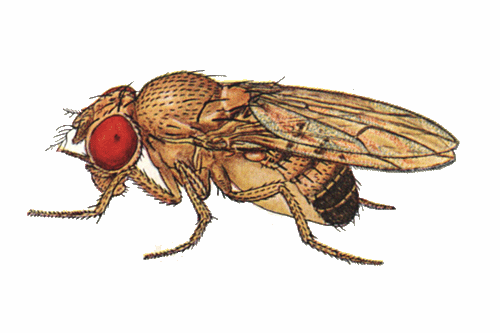Signaling pathways
regulating development, differentiation and growth
One of the unresolved
questions in biology is that of how organs grow.
Extracellular signals are known to play positive and negative
roles in cell proliferation and growth, which is also
influenced by nutrients, but so far it is not possible to
explain how organs measure their size, stop or renew growth,
and how growth is coordinated with morphogenesis to determine
organ shape. It is very plausible that cancer as well as
degenerative diseases including neurodegenerative diseases
reflect defects in these as-yet undefined but fundamental
processes.
In order to uncover and
characterize new genes controlling growth, our group uses
genetics to identify and study mutations with growth defects
in Drosophila melanogaster. Our current research
addresses the following new mechanisms of growth
regulation: 1) the relationship between cell fate and
cell proliferation, and how cell determination genes control
the cell cycle, especially during development of the nervous
system; 2) new mechanisms by which ribosomes regulate
growth; 3) cell competition, which is a way growing tissues
respond to the presence of cells with different growth
properties.
The approaches
used include mutagenesis studies to identify new
regulators of neural development, incorporating whole
genome sequencing and novel mapping methods for mutant
identification, physical biochemical studies of protein
dimerization in vitro, methods to detect specific protein
dimers in vivo, and developmental genetic analysis of gene
function in vivo.
1)
The proneural bHLH proteins are the master regulators
for most neuronal differentiation. These
transcription factors also coordinate the cell cycle
behavior. Defects in bHLH expression activate the
Hippo pathway of tumor suppressors and eliminate
progenitor cells. Current projects include how the
dimerization choices of different HLH proteins control
differentiation and growth, new evidence that protein
stability is important, and how HLH proteins and the
Hippo pathway also affect Wnt signaling. Aspects
of these studies are potentially relevant to
schizophrenia, which is linked to certain bHLH proteins,
possibly through control of dendrite morphogenesis.
2)
Ribosomes are, of course, essential for growth because
they are essential for protein synthesis. Our
group has discovered surprising novel signaling pathways
activated by defects in ribosome assembly. These
signals may play the major role in the growth defects
that result, more than any direct effects on
translation. These signaling pathways may explain
the symptoms of different human ribosomopathies and may
underlie the evidence that ribosomal protein genes can
be tumor suppressors, since they are unexpectedly
mutated in multiple human tumors. We will be
undertaking molecular studies of transcription and other
mechanisms of gene regulation in the Drosophila
pathways, and exploring the function of their mouse
counterparts in novel growth-regulatory pathways.
3) An emerging aspect of organ growth is ‘cell competition’. When organs contain cells growing at different speeds, cell competition can causes selective apoptosis of the out-competed cells only when they are close to the competing cell type. Even normal cells can be out-competed, for example if they are exposed to cells with an extra gene copy of the proto-oncogene Myc. Cell competition is thought to select for the fittest progenitor cells during organ growth and eliminate defective cells. Cell competition is suggested to play positive or negative roles in cancer development and may be a factor in the success of stem cell transplantation and regenerative therapies. Our lab is studying how differences in growth lead to cell competition, and its consequences for the detection and removal of cells with damaged DNA following irradiation and during aging, and plans to characterize the role of cell competition in mammals.
Recent publication
Kale, A., Ji, Z.,
Kiparaki, M., Blanco, J., Rimesso, G., Flibotte, S., and
Baker, N.E. (2018). Ribosomal protein S12e has a
distinct function in cell competition. Dev Cell 44:
42-55.
Bhattacharya, A., Li, K., Quiquand, M., Rimesso, G., and
Baker, N.E. (2017). The Notch pathway regulates
the Second Mitotic Wave cell cycle independently of bHLH
proteins. Dev Biol 431:
309-320.
Baker, N.E. (2017) Patterning the eye: a
role for the cell cycle? Dev.
Biol. 430:
263-5. PMID: 28733162
Baker,
N.E. (2017) Mechanisms of cell competition emerging from
Drosophila studies Curr Opin
Cell Biol 48:
40-46. PMID: 28600967
Lee, C.-H., Rimesso, G.,
Reynolds, D., Cai, J. and Baker, N.E. (2016) Whole
genome sequencing and iPLEX MassARRAY genotyping map an
EMS-induced mutation affecting cell competition in Drosophila
melanogaster. G3(Bethesda) 6:
3207-3217. PMID: 27574103
Baker, N.E. and Kale, A.
(2016). Ribosomal protein mutations: apoptosis, cell
competition and cancer. Mol Cell
Oncol 3:1,
e1029065. PMID: 27308545.
Kale, A., Rimesso, G. and
Baker, N.E. (2016). Local cell death changes the
orientation of cell division in the developing Drosophila wing
imaginal disc without using Fat or Dachsous as orienting
signals. PLoS One 11:
e0167637.
Wang, L.-H. and Baker, N.E.
(2015) E-proteins and Id-proteins: helix-loop-helix partners
in development and disease. Dev Cell35:
269-280. PMID: 26555048
Kale, A., Li, W., Lee, C.-H.
and Baker, N.E (2015) Apoptotic mechanisms during
competition of ribosomal protein mutant cells: roles of the
initiator caspases Dronc and Dream/Strica. Cell Death
Different 22:1300-1312.
PMID: 25613379
Wang, L.-H. and Baker,
N.E. (2015) Salvador-Warts-Hippo pathway in a
developmental checkpoint monitoring Helix-Loop-Helix
proteins. Dev Cell 32:191-202.
PMID: 25579975

